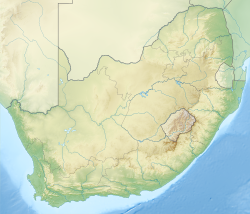This article needs additional citations for verification .(November 2025) |
| Wemmers River | |
|---|---|
| Location | |
| Country | South Africa |
| Region | Franschhoek, Western Cape |
| Physical characteristics | |
| Mouth | |
• coordinates | 33°50′1″S19°5′20″E / 33.83361°S 19.08889°E |
The Wemmers River is a river near Franschhoek in the Western Cape Province of South Africa. [1]
